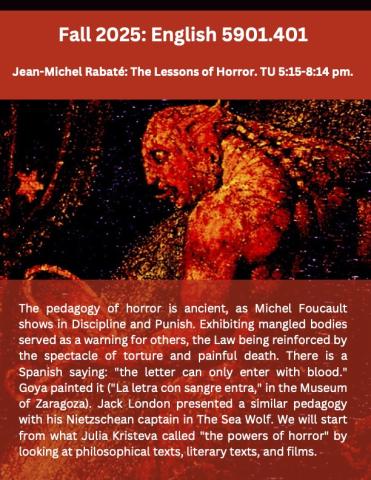The Lessons of Horror
The pedagogy of horror is ancient, as Michel Foucault shows in Discipline and Punish. Exhibiting mangled bodies served as a warning for others, the Law being reinforced by the spectacle of torture and painful death. There is a Spanish saying: "the letter can only enter with blood." Goya painted it ("La letra con sangre entra," in the Museum of Zaragoza). Jack London presented a similar pedagogy with his Nietzschean captain in The Sea Wolf. We will start from what Julia Kristeva called "the powers of horror" by looking at philosophical texts, literary texts, and films. We will first need to distinguish between Horror and Terror, and see how Hegel discusses the "Terror" moment in the French Revolution. We will explore parallels between Marquis de Sade and Immanuel Kant with Adorno, Horkheimer and Lacan. What are Sade's Libertines trying to teach in "The philosophy in the bedroom" and in revolutionary political pamphlets? We will follow Derrida when he meditates on cruelty and its links with the death sentence. We will ask about the rationale of terrifying acts of violence in Prometheus Bound, The Spanish Tragedy, and Titus Andronicus. Is there something to be learned from "torture porn" in films like Hostel, Green Inferno and Martyrs, from strategies of suicide bombing presented either in films (The Terrorist) or in historical analyses (Terror in the name of God)? What is the point of the pedagogy of horror deployed by Kafka ("The Penitentiary Colony") and Samuel Beckett (How It Is)? Is an ethics of care possible after one has perused Maggy Nelson's On Cruelty, and meditated on Conrad's denunciation of colonialism in Heart of Darkness?
-
20th-21st Century Concentration (AE21)

 Department of English
Department of English
